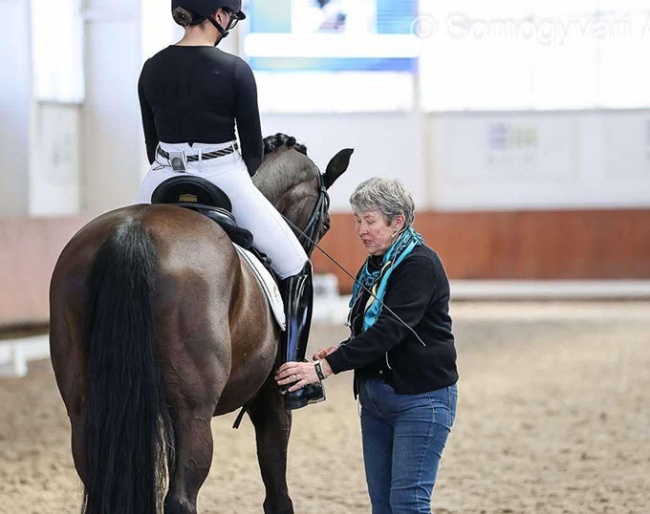
- Text by Sarah Warne-Furtado for Eurodressage
What happens when a rider who has ridden for a long time, perhaps their whole life, realises they just aren’t where they need to be? They are not effective in the saddle, or have not developed the aids, or posture needed to ride with any degree of relaxation and balance.
Just as a horse who knows all the exercises without any of the basics, a rider can often get the horse to do a lot, sometimes even compete at a high level, but yet lack the balance and relaxation required to achieve lightness, self carriage, and harmony with the horse.
It takes years to take a horse back to basics and reteach him how to stretch, how to use his back, how to collect without tension, how to engage from behind and swing forward into the contact.
For the rider it sounds simple. I want to ride like this, but I am not able to, so I must change. However, this is often one of the biggest hurdles to becoming a better, or even good rider, because this level of self reflection already requires a certain level of talent.
How Competent Am I?
According to the Dunning-Kruger effect, “people with limited competence in a particular domain overestimate their abilities." I find this especially true to horse riding.
We all know someone who says they are a very competent rider and they believe this to be true. The reality is rather different. Most of us also know the rider that says they still have so much to learn, and understands their many weaknesses, simply because they are already competent enough to have a functioning awareness of their level and ability.
So step one of course, is being good enough to understand how good (or not) you actually are. Step two is relearning how to be balanced in the saddle. Step one is a challenge. Step two takes a lot of work!
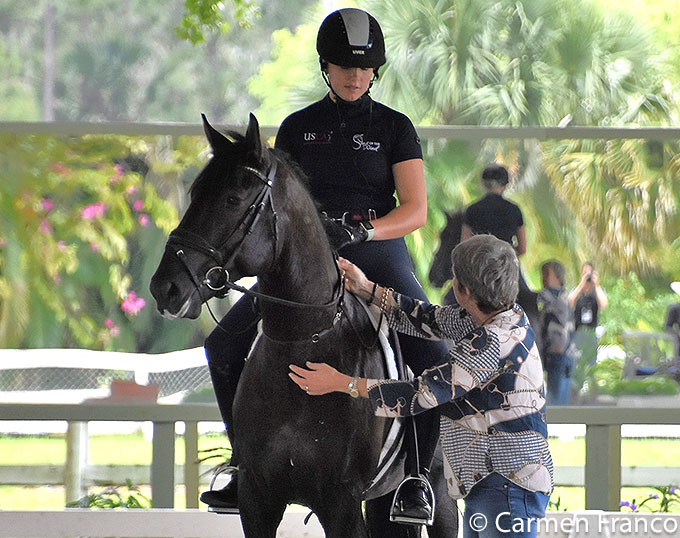
The Imbalance
“The imbalances of the rider show up on the horse,” says International dressage rider and trainer Kyra Kyrkland. “The horse will appear tense or will struggle to understand what the rider wants. It will be difficult for him to be working properly. He will not be in balance, and the pair probably won’t get very far in their schooling.”
Having trained so many winning combinations at the highest level, Kyra believes that riders who are not balanced but still somehow manage to get to a high level, will not be very successful.
“If you want to be successful in dressage today you can not use force or strong aids," she stated.
Kyra acknowledges that long-term rider imbalance or overuse of aids can cause lameness and other health issues for the horse In addition to a lack of success in both training and competition. So how long then does it take for a rider to become balanced and effective in the saddle?
“How long is a piece of string?" asks Kyra. “This depends a lot on how long they have been like that! Are they like that just on this horse, or on all horses?”
Where to begin?
So once a rider has understood they need to change and the amount of effort this with take, where do they begin?
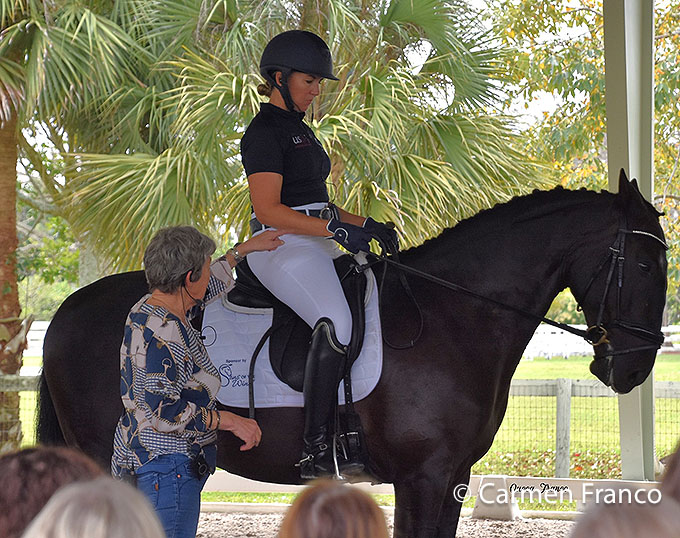
A useful technique, according to Kyra, is also to put the rider on a horse that is in balance and knows how to go correctly, so the rider can feel how it should be.
“Everything in riding is a question of feeling and feeling can be slightly different for different people,” says Kyra. “You have to be able to show the rider what sort of feeling you are looking for, or what feeling they should be looking for in the horse. Feeling is a sense, it is like smelling or seeing, you have to experience it to be able to recognise it.”
I asked if a rider who sits in a very correct position is more likely to be able to develop the correct feel.
“That depends. You can sit in a good position but still be stiff and if the seat and position are forced, then it is still difficult to feel. Muscles can’t be tense to feel properly," she stated.
In essence Kyra observes that in regards to position and feeling, “one gives to the other," and it is through a relaxed and balanced seat that one develops the correct feeling, and through correct feeling that one develops a relaxed and balanced seat.
“One way to achieve this would be to put riders on the lunge once a week. I found this really beneficial, as it taught them to use their weight, and to learn to ride the downward transition without the use of the reins,” explains Kyra. “If you squeeze yourself onto the horse, then you are going to use too much leg in the transition, and the horse will not stop. In this way you soon learn how to release the leg and use your weight to ask for the transition.”
Adapting to Change
So if a rider is out of balance or has an area of weakness that they need to relearn, what does it take to adopt a new way of riding?
“In gymnastics they say you must do something 100,000 times before something becomes automatic, so you do it unconsciously,” says Kyra. “If there is something that is not good, It takes 5000 repetitions (done correctly) to break the old habit, then another 100,000 to make it automatic.”
However, Kyra acknowledges that there are training short cuts that one can employ so they can make the changes more quickly.
“An example is if you have a rider with the hands down, like they are pushing a pram, then you can tell them to keep their hands like they would hold a glass of milk, without the milk spilling out. This is something that is already familiar to them and so that is a learning shortcut,” says Kyra.
Kyra stresses the role of the trainer in helping riders identify and feel when it is correct, addressing these old habits one at a time in a logical order, and employing shortcuts where possible, so riders don’t have to do it 100,000 times themselves, but can also mentally train that feeling.“A trainer must also find the main cause of the problem. Riders are very often told to use more legs, but not often told how to use the legs, or how to use the legs effectively.
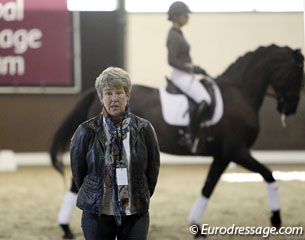
Believing that every rider can be improved, Kyra advises that still the most efficient way to improve the rider is to have them sit on a well schooled horse.
“The best teacher is a good horse.”
Consolidating Change
It is one thing to feel how to sit correctly, but in becoming a balanced rider we must also become a conscious, thinking one.
“It is important to understand the theory,” Kyra states. “The WHAT? WHY? and HOW? The WHY is important as the rider has to learn to analyse why something isn’t working . If you can find the real cause why something isn’t working, it’s easier to change what you are doing. The HOW is the most difficult. HOW should you use your leg, hand or weight more effectively? It is not only to use a stronger leg or hang on to the reins. HOW should you ride more forward? Is it just “speed” and you let the horse choose what rhythm of step or length of step the horse moves forward in? Or should you as the rider concentrate on keeping the same rhythm but a longer or shorter step (or vice versa),” Kyra explained..
Through this questioning and analysing, we create an understanding of our seat and aids, so when we get the right feeling on the horse, we don’t just know that it is correct, we understand why it is correct. Then slowly, we can develop the understanding of the when and by what degree to apply ourselves in the saddle.
Posture off the horse
As mentioned in the article “Becoming a Good Load to Carry," correct seat, and a good posture are inextricably linked, so anything you can do to improve your posture and balance off the horse will be beneficial in supporting the new influence on the horse.
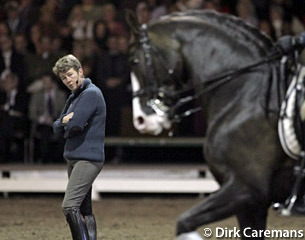
“If an athlete comes to me and they are with pain, or injury, or simply not reaching their objectives, I first need to look if their body is balanced. Where are they weak? Where are they strong? Where are they compensating? Then the goal is helping them to align their body and reestablish correct posture.”
Ana advises that this process, to realign someone who is out of balance or with pain or compensation, can take many months, even years to achieve, as the body has to relearn new patterns of movement.
“If someone is competing I would just try to alleviate tension and wait until the off season to start the work balancing their body. If you do it while they are competing you can risk them becoming less effective or sore while they adapt to the change.”
The important thing is to find an off the horse trainer or physiotherapist who understands or is interested in the sport of dressage.
Time for Positive Change?
It takes much work, patience, and humility to ride correctly and becoming a good rider is a big task. Becoming a far better rider than you were before? Perhaps an even bigger one, but the goal is clear…
"Take your reins like a flower, not like a stone. Take your horse by your waist and by your seat, not by your hand and never by force. If you do it by force, it is not the art of riding, it is something else," are Nuno Oliveira's striking words..
More Training Articles on Eurodressage
Archive photos © Anett Somogyvari - Carmen Franco - Astrid Appels - Dirk Caremans